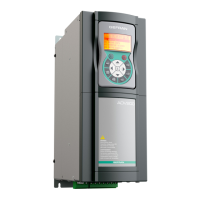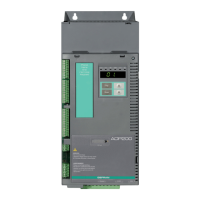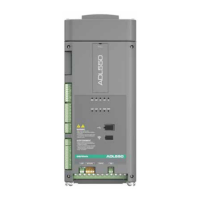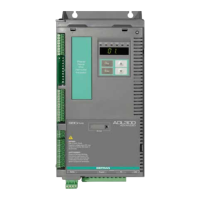Figure4.4.13Torqueboosting
Vmax
Vmid
2
Vmin
Fmid2
(01 - 04)
Fbase
( 01
-
12
Fmax
( 01
-
02
)
Vmid1
Fmid1
(
01
- 06)
Fmin
(01- 08)
)
When setting the frequency related parameters for a custom V/f curve values make sure that:
Fmax>Fbase>Fmid2>Fmid1>Fmin
(01-02)(01-12)(01-04)(01-06)(01-08)
The ‘SE03’ V/f curve tuning error is displayed when the frequency values are set incorrectly.
When 01-04 and 01-05 (or 01-18 and 01-19) are set to 0, the inverter ignores the set values of Fmin2 and
Vmin2.
The voltage values for 01-02~01-09 are irrelevant.
The value for maximum output voltage of motor 1(01-03) and the value for base output voltage of
motor 1(01-13) will depend on restore factory setting(13-08) to set the value of voltage.
When the control mode is changed parameter 00-00, 01-08 (Fmin) and 01-09 (Vmin) will automatically be
changed to the default setting of the selected control mode.
SLVorSVMode(SensorlessVectororSensorVectorControl)
Enter the motor data in parameter group 17 for SV and SLV control mode (00-00) and perform auto-tuning.
In the SV and SLV mode the V/f curve normally does not have to be re-adjusted after a successful auto-tune.
The maximum output frequency setting 01-02 (Fmax), base frequency 01-12 (Fbase), minimum output frequen-
cy 01-08 (Fmin), maximum output voltage 01-03 (Vmax) or base output voltage 01-13 (Vbase) can be adjusted
but the voltage is automatically adjusted by the internal current controller.
Set the base frequency (01-12, Fbase) to the motor rated frequency on the motor nameplate.
Perform the auto-tuning procedure after adjusting parameters 02-19 or 17-04 to reduce the voltage at no-load
operation.
Motor jitter can be reduced by lowering the no-load voltage. Please note that lowering the no-load voltage
increases the current at no-load.
* The setting of V/f curve in SLV2 is the same as that in VF mode
Code Parameter Name / Range
01-10 Torque compensation gain
0.0~2.0
In V/f or V/f + PG and SLV2 mode the inverter automatically adjusts the output voltage to adjust the output
torque during start or during load changes based on the calculated loss of motor voltage.
Torque compensation gain (01-10) can adjust in the running time. No need to adjust in general except the
following:
• If the wire between inverter and motor is too long, add the value of 01-10
• If the size of motor is smaller than inverter, add the value of 01-10.
• If the motor vibrates, reduce the value of 01-10
Refer to the torque compensation gain adjustment shown in Figure 4.4.14.
VDI100 • Instruction manual 135
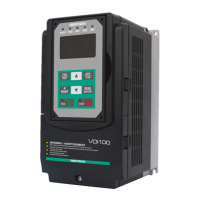
